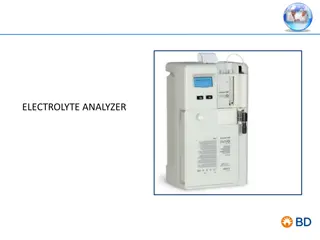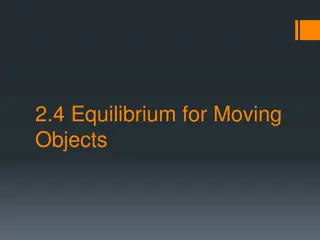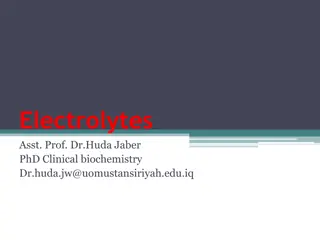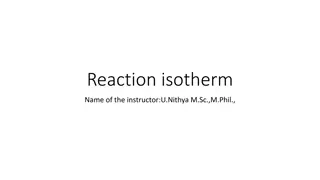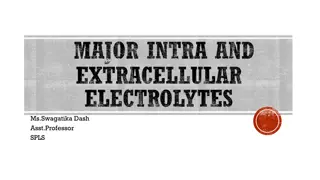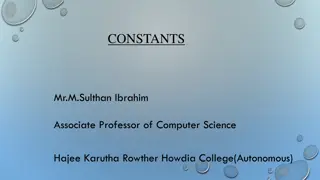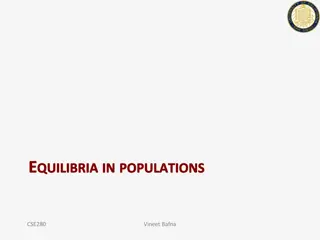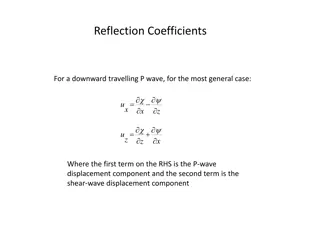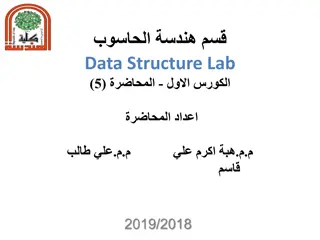Understanding Electrolyte Activity Coefficients and Equilibrium Constants
This article delves into the practical aspects of dealing with individual ions in aqueous solutions, particularly focusing on partitioning thermodynamic parameters between ions in salts. It explores the Debye-Hückel theory, which explains the electrostatic interactions between ions in solution and how these interactions are affected by ion concentration and charge. The Debye-Hückel Extended Law and Davies Laws are also discussed in the context of electrolyte solutions.
Download Presentation

Please find below an Image/Link to download the presentation.
The content on the website is provided AS IS for your information and personal use only. It may not be sold, licensed, or shared on other websites without obtaining consent from the author. Download presentation by click this link. If you encounter any issues during the download, it is possible that the publisher has removed the file from their server.
E N D
Presentation Transcript
Activity Coefficients; Equilibrium Constants Lecture 8
How do deal with individual ions in aqueous solution? We can t simply add Na+to a solution (positive ions would repel each other). We can add NaCl. How do we partition thermodynamic parameters between Na+and Cl ? For a salt AB, the molarity is: mA= AmABand mB= BmAB o as usual is the stoichiometric coefficient For some thermodynamic parameter (e.g., ) AB= A A+ B B So for example for MgCl2: MgCl2= Mg++2 Cl-
Practical Approach to Electrolyte Activity Coefficients Debye-H ckel and Davies
Debeye-Hckel Theory In an electrolyte solution, each ion exerts an electrostatic force on every other ion. These forces will decrease with the square of distance between ions. The forces between ions will be reduced by the presence of water molecules, due to their dielectric nature. As total solute concentration increases, the mean distance between ions will decrease. Thus electrostatic interaction, and consequently activity, should depend on the total ionic concentration. The extent of electrostatic interaction will also depend on the charge of the ions involved: the force between Ca2+and Mg2+ions will be greater at the same distance than between Na+and K+ions. In the Debye-H ckel Theory, a given ion is considered to be surrounded by an atmosphere or cloud of oppositely charged ions (this atmosphere is distinct from, and unrelated to, the solvation shell). If it were not for the thermal motion of the ions, the structure would be analogous to that of a crystal lattice, though looser. Thermal motion inhibits a fixed structure. The density of charge in this ion atmosphere increases with the square root of the ionic concentrations, but increases with the square of the charges on those ions. The dielectric effect of intervening water molecules will tend to reduce the interaction between ions.
Debye-Hckel Extended Law Assumptions o Complete dissociation o Ions are point charges o Solvent is structureless o Thermal energy exceeds electrostatic interaction energy Debye-H ckel Extended Law loggi=-Azi 1+ B I 2 I Where A and B are constants, z is ionic charge, is effective ionic radius and I is ionic strength: I =1 i 2 mizi 2
Debye-Hckel Limiting & Davies Laws Limiting Law (for low ionic strength) loggi= -Azi 2 I Davies Law: I -Azi 1+ I-bI 2 o Where b is a constant ( 0.3). Assumption of complete dissociation one of main limiting factors of these approaches: ions more likely to associate and form ion pairs at higher concentrations.
Activities in Solid Solutions Many minerals are also solutions. How do we compute activities of components in the solutions? For example, if we substitute Fe2+ for Mg2+ in forsterite, what are the activities of Fe2+ and Mg2+? Olivine Structure: Fe and Mg ions are located between unlinked silica tetrahedra
Mixing-On-Site Model Many crystalline solids, for example olivine, can be treated as ideal solutions. A simple ideal solution model is the mixing on site model, which considers the substitution of species in any site individually. In this model, the activity of an individual species is calculated as: ai,ideal = (Xi) where X is the mole fraction of the ith atom and is the number of sites per formula unit on which mixing takes place (the stoichiometric coefficient). For example, =2 in the Fe-Mg exchange in olivine, (Mg,Fe)2SiO4. Olivine has two (nearly identical) sites that can be occupied by Mg and Fe. We could treat them separately, then the activity of Mg would be, in effect, the sum of its activity in the two sites: aMg= i Xni For example, if Mg were distributed randomly between the two sites and the total mole fraction were 0.5, the activity would be 0.52 + 0.52 = 0.5. While olivine has two sites that can be occupied by Mg and Fe (M1 and M2), they are effectively equivalent. So we could simplify things by choosing (Mg,Fe)Si1/2O2 as the formula unit (we must then choose all other thermodynamic parameters to be 1/2 those of (Mg,Fe)2SiO4). In this case, the activity of Mg2+ is simply its mole fraction. o o
Activities of Phase Components Now suppose we chose of component to be not an ion, but a pure phase, such as pyrope, Mg3Al2Si3O12, in garnet, whose general formula is X3Y2Si3O12. Suppose the garnet of interest has the composition: 2+Mn.167Ca.156)(Al1.974Fe.044 2+)Si3O12 (Mg.382Fe2.316 The chemical potential of pyrope in garnet contains mixing contributions from both Mg in the cubic site and Al in the octahedral site. The activity of pyrope is thus given by: apy gt= Xpy gt= XMg 3XAl 2 =0.1263=0.002 For example: [Mg] aMg= XMg 3= [Mg]+[Fe2+]+[Mn]+[Ca]
Free Energy of Solution in Ideal Solid Solutions G = H T S o But H = 0 in the ideal case so Gideal mixing = -T Sideal mixing o where Sideal mixing is simply the configurational entropy: j i DSidealmixing=-R Xi,jlnXi,j nj In the pyrope example, the chemical potential of pyrope in garnet would be: mpy gt=mpy o+3RT lnXMg+2RT lnXAl= RT ln(XMg 3XAl 2)
The Equilibrium Constant Consider the reaction aA + bB = cC + dD The Free Energy change of reaction is: G = c C + d D a A b B At equilibrium: Expanding the term: ni i= 0 G = ni i o+ RT nilnai= 0 i ni ni i o+ RT ln = 0 a or We define the right term as the equilibrium constant: i i ni K = a i
Free Energy and the Equilibrium Constant i ni ni i o+ RT ln = 0 a i Since: o ni = Gr o i then o- RT lnK = 0 Gr and o= -RT lnK Gr Note of caution: our thermodynamic parameters are additive, but because of the exponential relation between the equilibrium constant and free energy, equilibrium constants are multiplicative.
Manipulating Equilibrium Constants Suppose we want to know the equilibrium constant for a reaction that can be written as the sum of two reactions, o e.g., we can sum Feaq Fe(OH)aq Fe(OH)aq 3++e- 2+ Feaq 2++ H+ 3++ H2O Feaq to yield o 2++e-+ H+ 2++ H2O Feaq The equilibrium constant of the net reaction would be the product of the equilibrium constants of the individual reactions. For this reason and because equilibrium constants can be very large or very small numbers, it is often convenient to work with logs of equilibrium constants: pK = - log K o (we can then sum the pK s). o
Apparent Equilibrium Constants and Distribution Coefficient In practice, other kinds of equilibrium constants are used based on concentrations rather than activities. Distribution Coefficient ni KD= Xi Apparent Equilibrium Constant ni Kapp= mi Kapp=Keq Keq = ni li Kl
Other Forms A solubility constant is an equilibrium constant. For example: K =aNa+ aNaCls aqaCl- aq o Since the activity of NaCl in halite = 1, then KSP= aNa+ aqaCl- aq Henry s Law constants for describing solubility of gases in solution (e.g., CO2 in water). o Since Pi = hiXi hi=Pi Xi
Law of Mass Action Important to remember our equation i ni K = a i describes the equilibrium condition. At non-equilibrium conditions the r.h.s. is called the reaction quotient, Q. Written for the reaction H2CO3 = HCO3- + H+ aHCO3 -aH+ K = aH2CO3 We can see that addition of H+ will drive the reaction to the left. Changing the concentration of one species in a reaction in a system at equilibrium will cause a reaction in a direction that minimizes that change .
Le Chateliers Principle We can generalize this to pressure and temperature: dG = VdP - SdT An increase in pressure will drive a reaction in a direction such as to decrease volume An increase in temperature will drive a reaction in a direction such as to increase entropy. When perturbed, a system reacts to minimize the effects of perturbation.
Temperature and Pressure Dependence Since G = H - T S and G = -RT lnK then o o lnK = - Hr + Sr RT R Temperature and pressure dependencies found by taking derivatives of this equation with respect to T: =DHr RT2 lnK T o P o (this is known as the van Hoff equation). For pressure, since DGr P =DVr T =-DVr lnK P o RT T
Oxidation and Reduction Redox refers to processes in which atoms gain or lose electrons, e.g., oxidation of iron: Fe2+ Fe3+
Valence and Redox We define valence as the charge an atom acquires when it is dissolved in solution. Conventions o Valence of all elements in pure form is 0. o Sum of valences much equal actual charge of species o Valence of hydrogen is +1 except in metal hydrides when it is -1 o Valence of O is -2 except in peroxides when it is -1. Elements generally function as either electron donors or acceptors. o Metals in 0 valence state are electron donors (become positively charged) o Oxygen is the most common electron acceptor (hence the term oxidation) Redox o A reduced state can be thought of as one is which the availability of electrons is high o An oxidized state is one in which the availability of electrons is low. Really idiotic pneumonic: LEO the Lion Says GRR: Loss Equals Oxidation Gain Refers to Reduction



